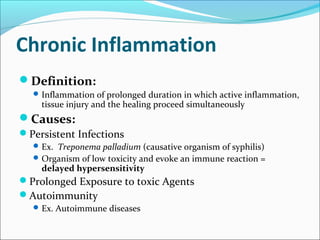
Chronic inflammation 2-1-2
- 1. Chronic Inflammation Definition: Inflammation of prolonged duration in which active inflammation, tissue injury and the healing proceed simultaneously Causes: Persistent Infections Ex. Treponema palladium (causative organism of syphilis) Organism of low toxicity and evoke an immune reaction = delayed hypersensitivity Prolonged Exposure to toxic Agents Autoimmunity Ex. Autoimmune diseases
- 2. Chronic Inflammation Morphologic Features: Infiltration with mononuclear cells (macrophages, lymphocytes & plasma cells) indicates persistent reaction to injury Tissue destruction Done by way of Inflammatory cells Repair involving angiogenesis and fibrosis Attempt to replace lost tissue
- 3. Chronic Inflammation Mononuclear Phagocyte System Circulating blood monocytes →Tissue macrophages ↓ Kupffer cells (liver) Sinus Histiocytes (spleen) Microglia (CNS) Alveolar Macrophages (lung)
- 4. Maturation of Mononuclear Phagocytes
- 5. Mechanisms of macrophage accumulation during Chronic Inflammation Continued recruitment of monocytes from the circulation Most important source for macrophages Local proliferation of macrophages from the blood stream Immobilization of macrophages within the site of inflammation Cytokines and oxidized lipids can cause immobilization
- 6. Effects of Macrophage Activation
- 7. Other Cells of Chronic Inflammation Infiltration with mast cells, lymphocytes and plasma cells Lymphocytes Mobilization in antibody – mediated response Mast Cells Widely distributed in connective tissues and participate in both acute and persistent inflammatory reactions Binds the Fc portion of the IgE antibody Plasma Cells Produce antibody directed either against persistent antigen in the inflammatory site or against altered tissue components Eosinophils parasitic infections Mediated by IgE Eotaxin – a chemokine that has the ability to prime eosinophils for chemotaxis
- 8. Granulomatous inflammation It’s a pattern of chronic inflammatory reaction in which the predominant cells are Aggregations of macrophages having an enlarged, squamous cell-like appearance (called Epitheloid macrophages) GRANULOMA = Nodular collection of Epitheloid macrophages surrounded by a rim of LYMPHOCYTES It’s a focal area of Granulomatous inflammation In an H&E stain can see: Epitheloid cells have pale granular cytoplasm with indistinct boundaries Giant cells = Epitheloid cells that fuse (Langhan’s) Can be found in the periphery or sometimes in the center of the granuloma Have large mass of cytoplasm Have 20 or more small nuclei arranged in the periphery or haphazardly
- 9. Granulomatous inflammation Types of Granulomatous Inflammation 1. Immune granulomas Caused by insoluble particles that are capable of inducing a cell-mediated immune response Macrophages are transformed into Epitheloid cells and multinucleate giant cells Examples: Bacteria Tuberculosis *** (high incidence due to drug resistant stains) Leprosy Parasites Schistosomiasis (3 types) Fungi Histoplasmosis Blastomycosis
- 10. Granulomatous inflammation 2.Foreign Body Granulomas Don’t incite either an inflammatory or immune response. Epitheloid cells and giant cells are apposed to the surface and encompass the foreign body. The foreign body is usually found in the center of the granuloma. Examples: Metal/Dust Berylliosis Silicosis Foreign body Splinter Suture
- 11. Granulomatous inflammation 3 Sarcoidosis Bad systemic disease, probably autoimmune disease Etiologic agent is unknown
- 12. LYMPHATICS IN INFLAMMATION Secondary line of defense Lymph flow is increased in inflammation and helps drain the edema fluid Lymphangitis Lymphadenitis
- 13. Third line of defense organisms gain access to the vascular circulation- Bacteremia next line of defense Phagocytic cells of the liver, spleen, and bone marrow heart valves, meninges, kidneys, and joints are favored sites of implantation for blood-borne organisms
- 14. Systemic Effects of Inflammation Infections→ reactions to cytokines ↓ Acute phase response or the systemic inflammatory response syndrome (SIRS) Acute phase response consists of
- 15. Acute phase response Fever-elevation of body temperature by 1° to 4°C pyrogens stimulate prostaglandin synthesis in the vascular and perivascular cells of the hypothalamus exogenous pyrogens (LPS) endogenous pyrogens (TNF, IL-1)
- 16. 1.Fever PGE2 via neurotransmitters such as cyclic AMP ↓ Reset the temperature set-point at a higher level ↓ Fever ↓ Fever induce heat shock proteins that enhance lymphocyte responses to microbial antigens
- 17. 2.Acute-phase proteins C-reactive protein (CRP) Fibrinogen Serum amyloid A protein (SAA) Synthesised by hepatocytes Synthesis is by upregulated by cytokines IL-6 (for CRP and fibrinogen) IL-1 or TNF (for SAA)
- 18. 2.Acute-phase proteins CRP and SAA act as opsonins helps in clearing Necroticcell nuclei Microbial cell walls Unlimited production of SAA - secondary amyloidosis in chronic inflammation
- 19. 3.Leukocytosis Common feature of inflammatory reactions Bacterial infection Usually 15,000 or 20,000 cells/μl,
- 20. 3.Leukocytosis contd… A) Accelerated release of cells from the bone marrow post - mitotic reserve pool ↓ (shift to the left) by cytokines B) Colony stimulating factors cause increase production of WBC
- 21. 3.Leukocytosis contd… Most bacterial infections induce Neutrophilia Viral infections-Lymphocytosis Typhoid fever , Rickettsiae-Leukopenia bronchial asthma, hay fever, and parasitic infestations- Eosinophilia
- 22. Other features of APR Effects of cytokines on brain cells Increased pulse and blood pressure Decreased sweating, Rigors (shivering) Chills (search for warmth) Anorexia Malaise
- 23. Sepsis Sepsis ;- severe bacterial infection Large amounts of LPS & TNF Multiple small thrombi by expressing Tissue Factor (TF) on Endothelial cells (EC) Septic shock – Triad 1. Liver failure – no Gluconeogenesis (Hypoglycemia) 2. Loss of perfusion pressure & heart failure – hemodynamic shock 3. Disseminated Intravascular Coagulation (DIC) – Multiple Thrombi in circulation & Fibrin split products Multi Organ Failure Mainly Lung , Liver also Kidney & Bowel
- 24. Consequences of impaired inflammation Defective inflammation Excess Inflammation ↑ susceptibility to Allergies infection Important in Delay in wound healing Cancer Tissue damage Atherosclerosis Fibrosis as a sequel of chronic infections, metabolic conditions
Notas del editor
- 1 d
